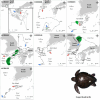Habitat use of loggerhead (Caretta caretta) and green (Chelonia mydas) turtles at the northern limit of their distribution range of the Northwest Pacific Ocean
- PMID: 38573996
- PMCID: PMC10994308
- DOI: 10.1371/journal.pone.0290202
Habitat use of loggerhead (Caretta caretta) and green (Chelonia mydas) turtles at the northern limit of their distribution range of the Northwest Pacific Ocean
Abstract
Verifying habitats, including the foraging and nesting areas for sea turtles, enables an understanding of their spatial ecology and successful planning of their conservation and management strategies. Recently, the observation frequency and bycatch of loggerhead (Caretta caretta) and green (Chelonia mydas) turtles have increased in the northern limit of their distribution range, in the northern part of the East China Sea and East (Japan) Sea. We conducted satellite tracking to investigate the habitat use of seven loggerhead and eight green turtles from June 2016 to August 2022 in this area, where little is known about their spatial ecology. We applied a 50 percent volume contour method to determine their main foraging areas and analyzed 6 environmental variables to characterize their habitats. Loggerhead turtles mainly stayed in and used the East China Sea as a foraging area during the tracking period, while two individuals among them also used the East Sea as a seasonal foraging area. Most green turtles also used the East China Sea as a foraging area, near South Korea and Japan, with one individual among them using the lower area of the East Sea as a seasonal foraging area. Notably, one green turtle traveled to Hainan Island in the South China Sea, a historical nesting area. Our results showed that the two sea turtle species included the East Sea as a seasonal foraging area, possibly owing to the abundance of food sources available, despite its relatively lower sea temperature. Considering that loggerhead and green sea turtles were observed using the northern part of the East China Sea and East Sea more frequently than previously known and that the sea temperature gradually increases due to climate change, conservation and management activities are required for sea turtles in these areas.
Copyright: © 2024 Kim et al. This is an open access article distributed under the terms of the Creative Commons Attribution License, which permits unrestricted use, distribution, and reproduction in any medium, provided the original author and source are credited.
Conflict of interest statement
The authors have declared that no competing interests exist.
Figures






Similar articles
-
Movement Patterns of Juvenile Loggerhead Turtles (Caretta caretta L. 1758) and Green Turtles (Chelonia mydas L. 1758) Hatched in Captivity and Released in the Korean Waters.Animals (Basel). 2022 Aug 22;12(16):2157. doi: 10.3390/ani12162157. Animals (Basel). 2022. PMID: 36009748 Free PMC article.
-
Unraveling migratory corridors of loggerhead and green turtles from the Yucatán Peninsula and its overlap with bycatch zones of the Northwest Atlantic.PLoS One. 2024 Dec 6;19(12):e0313685. doi: 10.1371/journal.pone.0313685. eCollection 2024. PLoS One. 2024. PMID: 39642124 Free PMC article.
-
Individual variation in feeding habitat use by adult female green sea turtles (Chelonia mydas): are they obligately neritic herbivores?Oecologia. 2006 Aug;149(1):52-64. doi: 10.1007/s00442-006-0431-2. Epub 2006 May 9. Oecologia. 2006. PMID: 16683139
-
Characterisation of the Gastrointestinal Microbiome of Green Sea Turtles (Chelonia mydas): A Systematic Review.Animals (Basel). 2025 May 29;15(11):1594. doi: 10.3390/ani15111594. Animals (Basel). 2025. PMID: 40509060 Free PMC article. Review.
-
Antimicrobial Pharmacokinetic Studies in Sea Turtles: A Review.J Vet Pharmacol Ther. 2025 Jan;48(1):1-14. doi: 10.1111/jvp.13492. Epub 2024 Nov 12. J Vet Pharmacol Ther. 2025. PMID: 39530192 Review.
Cited by
-
Identifying the source rookery of green turtles (Chelonia mydas) found in feeding grounds around the Korean Peninsula.PeerJ. 2024 Jun 20;12:e17560. doi: 10.7717/peerj.17560. eCollection 2024. PeerJ. 2024. PMID: 38912045 Free PMC article.
References
-
- Hamann M, Godfrey MH, Seminoff JA, Arthur K, Barata PCR, Bjorndal KA, et al.. Global research priorities for sea turtles: informing management and conservation in the 21st century. Endang Species Res. 2010;11: 245–269. doi: 10.3354/esr00279 - DOI
-
- Shimada T, Aoki S, Kameda K, Hazel J, Reich K, Kamezaki N. Site fidelity, ontogenetic shift and diet composition of green turtles Chelonia mydas in Japan inferred from stable isotope analysis. Endang Species Res. 2014;25: 151–164. doi: 10.3354/esr00616 - DOI
-
- Oki K, Hamabata T, Arata T, Parker DM, Ng CKY, Balazs GH. Inferred adult foraging grounds of two marine turtle species nesting at Amami-Oshima, Japan. Chelonian Conserv Biol. 2019;18: 91–97. doi: 10.2744/CCB-1337.1 - DOI
MeSH terms
LinkOut - more resources
Full Text Sources

